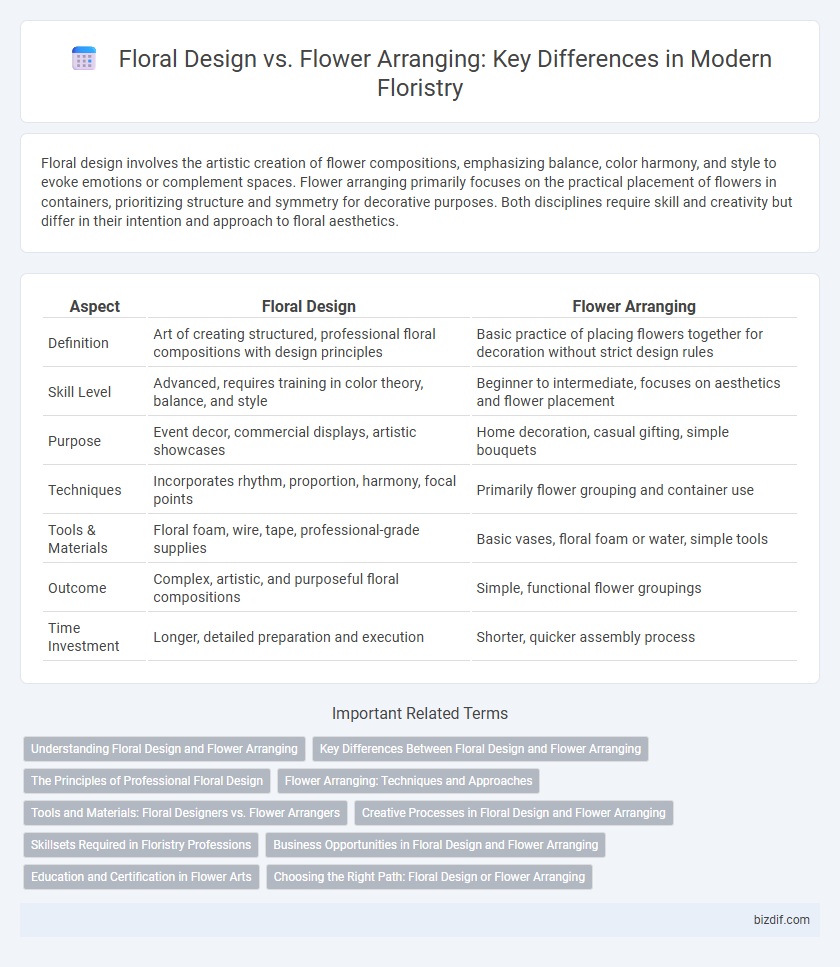Floral design involves the artistic creation of flower compositions, emphasizing balance, color harmony, and style to evoke emotions or complement spaces. Flower arranging primarily focuses on the practical placement of flowers in containers, prioritizing structure and symmetry for decorative purposes. Both disciplines require skill and creativity but differ in their intention and approach to floral aesthetics.
Table of Comparison
| Aspect | Floral Design | Flower Arranging |
|---|---|---|
| Definition | Art of creating structured, professional floral compositions with design principles | Basic practice of placing flowers together for decoration without strict design rules |
| Skill Level | Advanced, requires training in color theory, balance, and style | Beginner to intermediate, focuses on aesthetics and flower placement |
| Purpose | Event decor, commercial displays, artistic showcases | Home decoration, casual gifting, simple bouquets |
| Techniques | Incorporates rhythm, proportion, harmony, focal points | Primarily flower grouping and container use |
| Tools & Materials | Floral foam, wire, tape, professional-grade supplies | Basic vases, floral foam or water, simple tools |
| Outcome | Complex, artistic, and purposeful floral compositions | Simple, functional flower groupings |
| Time Investment | Longer, detailed preparation and execution | Shorter, quicker assembly process |
Understanding Floral Design and Flower Arranging
Floral design involves creating aesthetically balanced and visually appealing compositions that consider elements such as color harmony, texture, form, and space, often used in professional settings like weddings or events. Flower arranging focuses more on the practical assembly of flowers into bouquets or centerpieces, emphasizing the placement and combination of blooms for visual impact. Understanding the principles of floral design enhances flower arranging skills by incorporating artistic concepts and design theories, resulting in more sophisticated and cohesive floral presentations.
Key Differences Between Floral Design and Flower Arranging
Floral design involves the artful composition of flowers, incorporating principles of design such as balance, color harmony, and spatial awareness to create aesthetically pleasing and purposeful arrangements. Flower arranging primarily focuses on placing flowers in containers for decorative purposes without necessarily adhering to formal design principles. The key differences lie in floral design's emphasis on creativity, structure, and technique versus flower arranging's simpler, more casual approach.
The Principles of Professional Floral Design
The principles of professional floral design emphasize balance, proportion, rhythm, and harmony to create visually appealing and cohesive arrangements. Unlike simple flower arranging, floral design integrates color theory, line, texture, and space to convey mood and style effectively. Mastery of these principles differentiates expert florists by enhancing the artistic and structural quality of each floral creation.
Flower Arranging: Techniques and Approaches
Flower arranging focuses on the precise placement of blooms to create visually pleasing compositions with balance, rhythm, and harmony. Techniques include wiring, taping, and using floral foam or chicken wire to secure stems and shape arrangements. Approaches vary from traditional styles like Ikebana to modern, freestyle designs, emphasizing creativity and functionality in space utilization.
Tools and Materials: Floral Designers vs. Flower Arrangers
Floral designers utilize specialized tools such as floral foam, wire, tape, and floral knives to create structured, artistic compositions, while flower arrangers often rely on basic materials like vases, scissors, and floral tape for simpler displays. Designers prioritize materials that support durability and intricate designs, including various floral preservatives and conditioning agents to extend flower life. Flower arrangers focus on accessibility and ease, using readily available flowers and basic tools suited for casual or decorative purposes.
Creative Processes in Floral Design and Flower Arranging
Floral design emphasizes artistic expression through principles of balance, color theory, and texture, creating visually impactful compositions. Flower arranging involves the practical placement of blooms to achieve harmony and structural integrity. Both practices require an understanding of floral mechanics and plant varieties but differ in creative intent and complexity.
Skillsets Required in Floristry Professions
Floral design demands a deep understanding of color theory, spatial composition, and plant biology to create aesthetically balanced and meaningful arrangements. Flower arranging primarily requires technical skills in handling, cutting, and placing flowers effectively for visual appeal and longevity. Mastery in both areas involves creativity, precision, and knowledge of floral materials, but floral design includes conceptual planning and artistic expression beyond basic arranging techniques.
Business Opportunities in Floral Design and Flower Arranging
Floral design offers expansive business opportunities through customized event styling, including weddings, corporate functions, and interior decor, leveraging creativity and trends to attract high-paying clients. Flower arranging focuses on traditional bouquet making and retail sales, providing steady income streams in local markets and floral shops. Both fields benefit from digital marketing and e-commerce platforms, but floral design commands premium pricing due to its artistic and bespoke nature.
Education and Certification in Flower Arts
Floral design education encompasses comprehensive coursework in color theory, plant biology, and creative techniques, leading to certifications such as the Certified Florist (CF) or Master Floral Designer credentials. Flower arranging often involves more practical, hands-on training focused on event styling or bouquet creation, frequently offered through shorter workshops or community classes without formal certification. Professional programs in floral arts provide in-depth skill development and recognized accreditation, essential for career advancement in the floral industry.
Choosing the Right Path: Floral Design or Flower Arranging
Floral design emphasizes artistic composition, combining elements such as color theory, balance, and texture to create visually compelling installations for events, retail, and interior spaces. Flower arranging focuses on arranging blooms in containers, prioritizing practical skills for everyday bouquets and simple decorations. Selecting the right path depends on whether your passion lies in creative expression and complex design techniques or practical, hands-on arrangement skills for personal or commercial use.
Floral Design vs Flower Arranging Infographic

 bizdif.com
bizdif.com